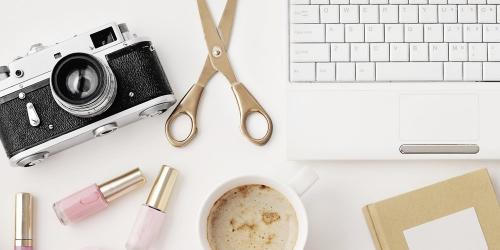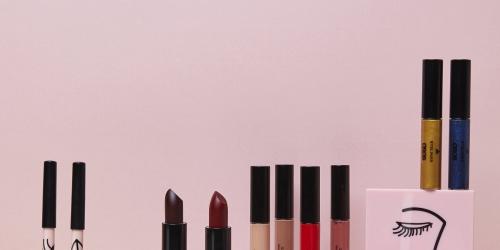They are made up of a dog truffle, a Bambi mask or a halo of light and a wreath of flowers: like these filters that are used on the Snapchat photo sharing application. But this time, it is on a podium in New York, during the last fashion week, that these faces parade for Desigual: make-up, made by the Mac teams, inspired not of the street or of art but of social networks. Additional proof, if need be, that these new technologies and the universe of beauty are interwoven to the point of mixing in the minds of creators, who have no choice but to integrate them into their strategy .
While make-up techniques such as contouring or strobing were created primarily for parades, it is also the beauty bloggers who ensure its popularity and durability.
And they become, especially for the youngest, the new references, thanks to their blogs, their YouTube channels and their accounts on the social networks (Snapchat, Instagram, Facebook ...).
But how did these media become the new mirrors?
Blogging and beauty youtubeuses: the new queens of the Web
On May 28, 2016, at the Parc Floral de Paris, hundreds of overexcited young girls leave their autograph books. Not for the new reality show stars, but for the first edition of Get Beauty , which brings together the "biggest" French beauty bloggers. On display: Sananas , 27 (1.2 million subscribers on Instagram) (1), Horia , 20 years old (995,000), or Clara Channel , 17 years old (948,000). Names that do not evoke you anything. Yet they are the new queens of beauty.
On the day of the opening of the ticket office, the site broke down. The reason ? Too many connections. In just a few minutes, nearly ten thousand notes have passed. A success that recalls that of the American edition, Beautycon, which exists since 2013 and where a "full VIP" access is sold for $ 269.99 (about 245 €).
New rituals of socialization of beauty
On their blogs or YouTube channels that drain hundreds of thousands of subscribers, especially young people, they test products, try new things, give advice and decode the latest trends.
"As the main socialization rituals of beauty have disappeared, the videos and photos of these bloggers act like portable bathrooms, confirms the body philosopher Bernard Andrieu. By making you enter their privacy, they recreate their bathroom in front open a space that has long been intimate and hidden behind a closed door, in which the physical transformation of women was played out. "
"Girls next door" versus superstar bloggers
"In fact, I think that beauty bloggers bring a lot of freshness: they are lambda but passionate girls who talk to other enthusiasts," says Beautylicieuse .
This thirty-year-old, who launched her blog seven years ago, claims 300,000 unique visitors per month and 56,000 followers on Instagram.
Yet you will never see his face: "I did not feel the need to put myself forward. I do not make tutorials but I give info."
This is far from the case of the majority of its counterparts, who have become Web starlets who master the codes of staging.
Annual compensation of up to € 150,000
Among those who started as "girls next door" testing a lipstick in front of their webcams, the most gifted ones settled at the top of real empires, the first were American.
With annual sales of up to 50 000 or 150 000 € for the most famous ones (sponsored articles, contracts with brands, public appearances ... not counting benefits in kind).
70% of women follow the beauty tips of influencers
However, Capucine Piot (52,300 followers on Instagram) nuances this role of "experts", often attributed to the influencers: "I do not think that we can say that bloggers are experts, but rather very curious consumers. the popularity of our blog allows us to meet many people and to test a lot of things. If the brands appeal to us, it is that besides the starification on the networks, we bring credibility, a label.
According to a study carried out for Birchbox, 70% of women follow the recommendations of youtubeuses to the letter, and 46% buy the exact reference of the product.
Tuto, DIY ... The new lexical field of beauty
"I spend a lot of time copying make-up on the Internet," says Lea, 26, a graphic designer who is no more masked than anyone else, "Instagram or Pinterest, where I learn to reproduce things. can spend hours on weekends trying to redo a makeup that a blogger has proposed on a tutorial. "
With their vocabulary ("tuto", "DIY", "routine") and their codes, social networks have become established in a few years as the new laboratory of beauty.
Developing a prescription capacity almost as strong as a parade or a women's magazine, they have become these new salons where trends are popularized or disappear with incredible rapidity.
Contouring and other trends: new prescribers
Contouring is the best example. This technique, which allows to redraw the facial features thanks to a play of shadows and lights, was originally used by make-up artists for the world of the stage, before celebrities popularized it on the networks.
The history of its success on Google is striking: at the end of 2014, bloggers are starting to publish tutorials; mid-2015, Kim Kardashian explains, in his own way, how to reproduce it; and at the end of the year, there is a peak of online research on the subject.
An intuition confirmed by the figures: according to an OpinionWay study conducted for Amazon Beauty Prestige last September, a third of women today favors online inspiration for beauty trends and makeup techniques, and more than a third 'amuse to reproduce the beauty tutorials. A figure that reaches 58% when focusing on the 25-35 age bracket.
The notion of "tribe"
For the ethnologist Elisabeth Azoulay, who directed the edition of 100,000 years of beauty (3) , this ritualization of beauty is nothing new, if not its numerical character.
"In the past, women passed their techniques and beauty advice through small papers that the bourgeoisie and aristocrats wrote for their daughters, filled with recipes, tricks, etc. A mother / daughter literature that can be considered as the" the cosmetics industry has fulfilled this role for about fifty years, and the brands explained to women how to use their products, for example Helena Rubinstein organized "beauty class" in the 1920s.
That was before digital turned things upside down. "Today, you do not expect brands to tell you how to put on make-up. They offer you products, but it is to a girl who resembles you, who is part of your tribe, that you will trust. "
"Today's girls learn everything about YouTube"
A feeling confirmed by Shirley, 28, optician. "I was thinking recently that I did not go to a hairdresser anymore if I had not seen the before / after on his Instagram. I need to be pretty sure what I'm going to do to me. "
Faced with a very dynamic offer where hundreds of new palettes of eyeshadow arrive monthly in shelves, bloggers have a role of needleworker.
"Girls need advice in the face of multinational cosmetics," says Capucine Piot, who launched her Babillages blog a decade ago, which she defines today as a "webzine", not hesitating to criticize the brands, which is not always done to please.
"The fifties were redrawing eyebrows like movie stars, my generation was watching pop music videos, and today's girls learn everything about YouTube."
This ritualization of beauty is nothing new, except its numerical character.
Brands serving bloggers
Watching from a distance all this little world shake, some brands quickly realized that they could no longer, now, do without bloggers or social networks.
Last October, L'Oréal Paris chose Kristina Bazan as its muse.
In 2015, Maybelline made thirty videos with EnjoyPhoenix, titled "T'as pas du gloss?", Which generate no less than nine million shared views.
"Through the body of the blogger, brands touch virtual bodies , " analyzes Bernard Andrieu. And a huge invisible market with shapeless contours.
For them, a presence on the networks is worth more than any campaign orchestrated with millions of euros.
The new strategy of the multinationals against the influential
In 2013, Sephora launches Generation Sephora, a site dedicated to 14-17 year olds who offers tutos and beauty advice. A few months later, the brand offers a platform to "continue the shopping experience online" by allowing consumers to take a picture of their looks and tag the products used.
Exactly like a blogger on Instagram.
"The community aspect and the close relationship on the social networks allow Sephora to address directly to their fans and followers through impacting digital content , " said the brand. Who communicates exclusively on his new products via his account Instagram or delivers tricks and tutorials on Snapchat.
By apeking bloggers in the way of addressing their community, brands profit mostly from networks to boost their sales.
A "Photoshop Effect" that can be seen very clearly on certain sectors of the make-up industry.
The buzz effect of social networks, a sales booster for brands
"A buzz on the networks has a very clear effect on the sales in stores, explains Mathilde Lion, beauty expert at NPD.
While the cosmetics market is globally declining in France, some sectors are explosive, such as complexion, with concealer ( 5%) and highlighters ( 7%), or eyebrows ( 50% in three years) . These products are popularized by the younger ones, who have a strong ability to recommend to other generations. "
As a result, some brands have gone so far as to surf the "selfie" trend by proposing ranges dedicated to their consumers with the camera grafted to the wrist: palette #TFnofilter Too Faced, foundation "photo ready" or "HD ", or packaging smartphone for Accord Parfait by L'Oréal Paris.
Snapchat, Instagram, Youtube: a community mirror
"Social networks make us reflect us in a new community mirror and crystallize a new form of beauty," laments Bernard Andrieu.
Do they risk giving us the same head? Just see how the photos of young girls began to look alike this summer after they discovered the Snapchat filters that make up virtually without having anything to do.
Photos that have swept across the networks, where we ended up in spite of ourselves facing an army of future Kim Kardashian.
1. This is the number of followers per hour we write. 2. #Enjoy Marie de Marie Lopez, ed. Pocket. 3. Collective work, ed. Gallimard.



